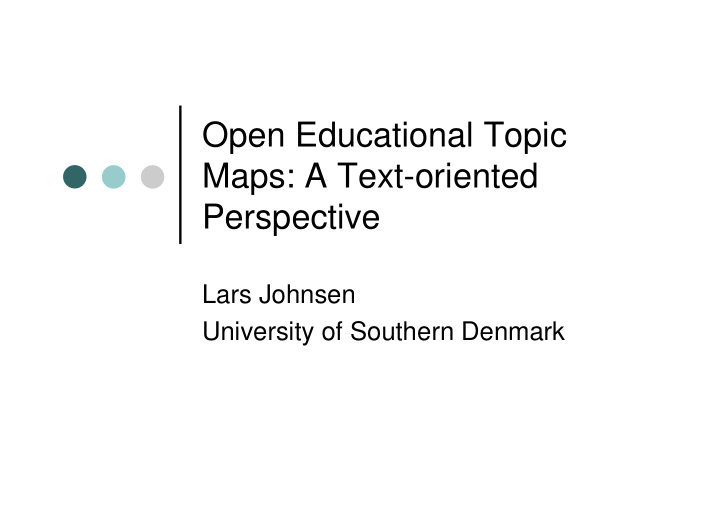



Open Educational Topic Maps: A Text-oriented Perspective Lars Johnsen University of Southern Denmark
The seven C’s of educational TM Subject Communi- Reuse, matter cation interopera- bility Cohesion Information Content & Compliance system Coherence Environment Concepts Contexts Connectivity
An e-learning architecture based on TM Modules Communication layer Topic maps Knowledge layer Media Resource layer elements
An approach … Rhetorical Structure Theory Structured Writing CNXML
CNXML � Connexions project � Document-oriented � No markup for domain < cnxml > knowledge structures < > ….. < > ….. < > or subject identity …….. < > …. < > ….< >. � But: elements with < > ….. < > ….. < > …….. < > …. < > ….< >. source attribute (term, < > ….. < > ….. < >….. < foreign) > …. < > ….< >. � Alternative: DITA < /cnxml > <term src=”http://www.example.org/xyz”>xyz</term>
Structured Writing � Guidelines for � analyzing, � organizing, � presenting and � sequencing content Inventor: Robert Horn
The principle of chunking � Chunk content into small units: � Information blocks (one informational objective) � Information maps (five to nine blocks)
The principle of labeling � Labels support scanning and Label browsing � They indicate contents or Label communicative function Label
The principle of relevance � Concept � Procedure Keep � Process information � Structure types apart! � Fact � Principle � Classification Information types
The principle of consistency � Be consistent � structurally � visually � linguistically Often tabular formats … Step Action 1 Do this 2 Do that
Why Structured Writing? � Raising awareness � Conceptual affinity Topic between topic maps and Occurrence type information maps � Unified Occurrence presentation format Formatted file Topic maps data
Why Structured Writing II? � Content layering � Adding blocks and maps to blocks and maps (like Legos) � = Laying facts upon facts, facts upon concepts, etc.
Why Structured Writing III? � Information extraction <term>XYZ</term> consists of: Part Function <term> … CNXML + Structured Writing <term> …
Rhetorical Structure Theory � Cohesion � Text as hierarchy � Coherence � Nuclei vs satellites � Rhetorical relations 1) The butler was the murderer. He was holding the smoking gun. 2) Sherlock Holmes had identified the culprit. The butler was the murderer.
Some rhetorical relations � Elaboration � Preparation � Background � Restatement � Summary � Enablement � Motivation
Communicative structures I Topic type Instance of Summary Definition (satellite) Topic Background Description (nucleus) Topic maps Modules Elaboration
Communicative structures II Some Any Contrast Reification Declarative clause Explanation Explanation Interrogative clause
Communicative structures III Topic A Topic B Association 1 Reification Association 3 = rhetorical relation Reification Topic X Topic Y Association 2
Rounding off … � From communication to learning � The relation to Polyscopic Topic Maps � The need for: � Tools � Open repositories Thank you!
Recommend
More recommend